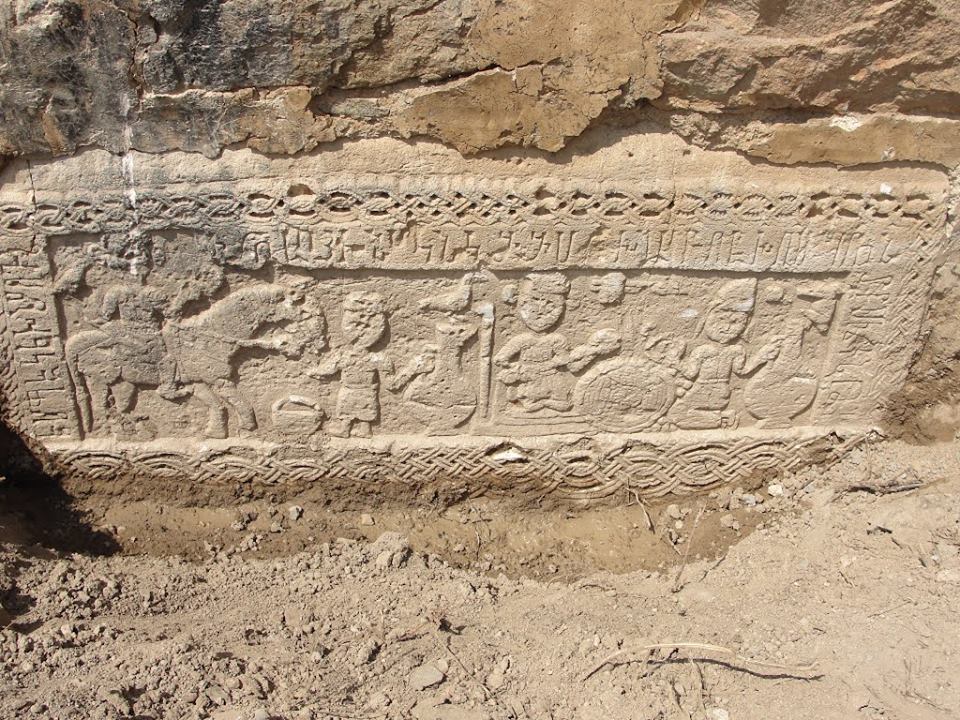DaŇübulaq, Shamkir on:
[Wikipedia]
[Google]
[Amazon]
DaŇübulaq is a village and municipality in the
 As with many ancient ruins in the Caucasus, the history of the ancient church ruins is disputed. In 2016, Russia-born Azerbaijani translator and historian Afgan Khalili (∆Źfqan X…ôlilli) published an overview of the existing scholarship on the site which, to locals the site is known as ńįrmaŇüli Piri, i.e. a holy site rather than a church per se. He interrogates the Armenian sources of Samvel Karapetyan who photographed the ruins in 1985 and recorded the name in Armenian as Huskan Natahak Vank, based on Armenian-language newspaper stories of the 1880s. However, at the time that Karapetyan visited, many Armenians lived in nearby Bado and none reported any memory of the site being a church during recent history. Many ancient inscription stones are dotted around the site, or reset into walls but in a fashion that suggests that their location is a part of a somewhat haphazard restoration. Videos posted in 2019 suggest that part of the roof has collapsed threatening the interior with further damage.
As with many ancient ruins in the Caucasus, the history of the ancient church ruins is disputed. In 2016, Russia-born Azerbaijani translator and historian Afgan Khalili (∆Źfqan X…ôlilli) published an overview of the existing scholarship on the site which, to locals the site is known as ńįrmaŇüli Piri, i.e. a holy site rather than a church per se. He interrogates the Armenian sources of Samvel Karapetyan who photographed the ruins in 1985 and recorded the name in Armenian as Huskan Natahak Vank, based on Armenian-language newspaper stories of the 1880s. However, at the time that Karapetyan visited, many Armenians lived in nearby Bado and none reported any memory of the site being a church during recent history. Many ancient inscription stones are dotted around the site, or reset into walls but in a fashion that suggests that their location is a part of a somewhat haphazard restoration. Videos posted in 2019 suggest that part of the roof has collapsed threatening the interior with further damage.2019 video of the church site
/ref>
Shamkir Rayon
Shamkir District ( az, Ňě…ômkir rayonu) is one of the 66 districts of Azerbaijan. It is located in the north-west of the country and belongs to the Gazakh-Tovuz Economic Region. The district borders the districts of Gadabay, Tovuz, Samukh, Goy ...
of Azerbaijan
Azerbaijan (, ; az, Az…ôrbaycan ), officially the Republic of Azerbaijan, , also sometimes officially called the Azerbaijan Republic is a transcontinental country located at the boundary of Eastern Europe and Western Asia. It is a part of th ...
. It has a population of 591 and sits on a ridgetop in the foothills of the Lesser Caucasus
The Lesser Caucasus, also called Caucasus Minor, is the second of the two main mountain ranges of Caucasus mountains, of length about . The western portion of the Lesser Caucasus overlaps and converges with east Turkey and northwest Iran.
It runs ...
.
It is sometimes known as Dańü ńįrmaŇülńĪ as there is a strong family connection between the village and the small town of ńįrmaŇülńĪ
ńįrmaŇülńĪ (pronounced Irmashly) is a large village and municipality in the Shamkir Rayon of Azerbaijan. It has a population of 4,001.
History
ńįrmaŇülńĪ combines an ancient Azerbaijani settlement with the 19th-century German 'colony' village o ...
on the plains below, though at present the only roads between the two are unpaved and unsuitable for city cars. There is a small, recently semi-restored Caucasian-Albanian church ruin on the lip of the ridge surveying a wide panorama to the north.
The Church Ruin
 As with many ancient ruins in the Caucasus, the history of the ancient church ruins is disputed. In 2016, Russia-born Azerbaijani translator and historian Afgan Khalili (∆Źfqan X…ôlilli) published an overview of the existing scholarship on the site which, to locals the site is known as ńįrmaŇüli Piri, i.e. a holy site rather than a church per se. He interrogates the Armenian sources of Samvel Karapetyan who photographed the ruins in 1985 and recorded the name in Armenian as Huskan Natahak Vank, based on Armenian-language newspaper stories of the 1880s. However, at the time that Karapetyan visited, many Armenians lived in nearby Bado and none reported any memory of the site being a church during recent history. Many ancient inscription stones are dotted around the site, or reset into walls but in a fashion that suggests that their location is a part of a somewhat haphazard restoration. Videos posted in 2019 suggest that part of the roof has collapsed threatening the interior with further damage.
As with many ancient ruins in the Caucasus, the history of the ancient church ruins is disputed. In 2016, Russia-born Azerbaijani translator and historian Afgan Khalili (∆Źfqan X…ôlilli) published an overview of the existing scholarship on the site which, to locals the site is known as ńįrmaŇüli Piri, i.e. a holy site rather than a church per se. He interrogates the Armenian sources of Samvel Karapetyan who photographed the ruins in 1985 and recorded the name in Armenian as Huskan Natahak Vank, based on Armenian-language newspaper stories of the 1880s. However, at the time that Karapetyan visited, many Armenians lived in nearby Bado and none reported any memory of the site being a church during recent history. Many ancient inscription stones are dotted around the site, or reset into walls but in a fashion that suggests that their location is a part of a somewhat haphazard restoration. Videos posted in 2019 suggest that part of the roof has collapsed threatening the interior with further damage./ref>
References
* Populated places in Shamkir District {{Shamkir-geo-stub